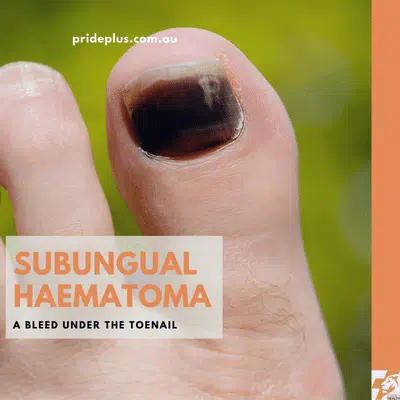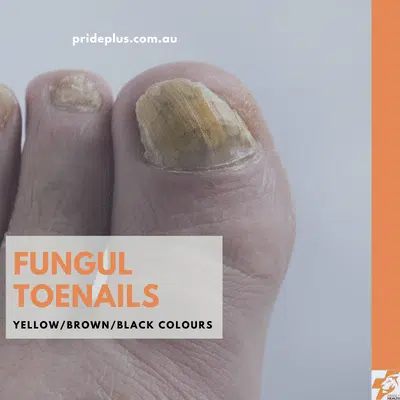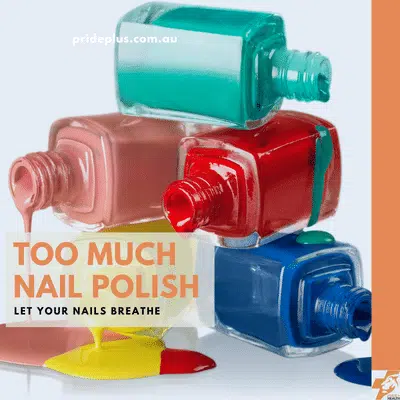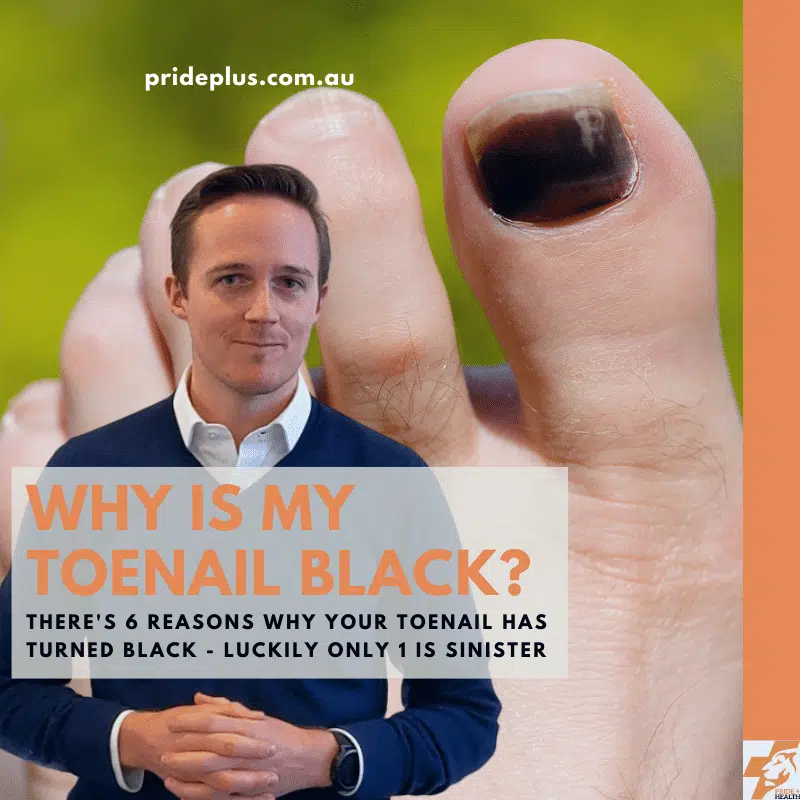Hey Tim, you’re a podiatrist – can you help me out – Why is my toenail black?
As the saying goes, if I had a dollar every time I was asked that question… I’d have a fair few dollars, particularly from runners here in Melbourne who ramp up their training for one of our great marathons.
There can be a few different reasons why your toenail has gone black. The most common relates to trauma but there are a few sinister (and not so sinister) reasons why your toenail becomes black. Let me help you work out which black toenail you have – and give a few pointers on what to do to.
As always, while I’ve been a podiatrist for many (some say too many) years, and this information is what we discuss in clinic one on one, it remains general advice for you. For specific advice about your own black toenail you’ll need a consultation with your podiatrist.
So, without further ado, here’s the top 6 reasons why your toenail is black.
- Blood under the nail
- Fungal toenail infection
- Bacterial infection
- Melanoma
- Certain medical conditions
- Staining from nail polish
Let’s take a look in more detail.
You have a bleed under your nail

What’s a bruise? It’s a bleed under your skin. Well, a bleed under your nail is called a subungual haematoma.
Just like a bruise on the skin, subungual haematomas can come in different levels of severity. You can get wild big bleeds under your nail which are incredibly painful as the toe is very sensitive. There’s also mild subungual haematomas where there’s only a small bleed and sometimes no pain at all.
To get a bleed under the nail, there needs to be trauma or damage to the area. Long distance runners, fast bowlers and dancers are all familiar with black toenails from bleeding and trauma. These activities all bring the tops of the toes into contact with shoes and the ground and damage and bleeding can occur.
Then, there’s the clumsy amongst us.
Hands up if you’ve stubbed your toes on the corner of the coffee table and after swearing black and blue, you look down and see your toe has started to go the same colours?
I see you! I’m guilty of this too.
It does feel at times that our little toes are just there to catch the corner of the bed, couch of coffee table when we plod about at home. These knocks can lead to a subungual haematoma with damage and bleeding happening between your toenail and your toe.
If you think your toenail is black from trauma leading to a bleed under the nail, I’ll take you through what you can do a little later in the post.
A short list of triggers that can increase the chance of bleeding under the nails being the cause of your black toenails.
Black toenail triggers
- Activities that lead to repetitive trauma (dancing, marathon running, fast bowling in cricket)
- Shoes that are too short
- Blood thinners (anti-coagulants)
- Long toenails
- Thick toenails due to previous damage or fungus
- Tearing or ripping at toenails
Toenail fungus could be the cause of your black toenails

Fungal toenails? Those little mushrooms (ok, cousins of mushrooms) that live on our skin normally can infect and thrive within your toenails causing them to go black.
There are three culprits that can cause your black toenails.
- trichophyton rubrum
- epidermophyton floccusum
- trichophyton mentagrophytes
Great names for things that are not great when they’re growing on your toenails.
If any of those 3 types of fungus have their ideal growing conditions (warm, dark, maybe a little moisture, and plenty of food) they can take over. What makes working out the cause of your black toenails a little tricky here is that if you have a subungual haematoma, that dry blood can be exactly the sort of food the fungus loves.
So you might originally have a black toenail from a bleed under the nail, but if you’re not careful, this can turn into a fungal toenail pretty easily.
Here are some tell-tale signs that you might experience with a toenail fungus infection
- Yellowish, brownish tinge to the black discoloration
- Crumbling or friable edges
- Thickening or hardening of your toenail
If you’d like to find out if you do have a toenail fungus infection you can take the free online toenail fungus test here.
Bacterial infections of the toe and nail
Oh you thought a fungal toenail infection was bad? It could actually be something much worse.
Usually when we think of bacterial infections of the skin and nail we think of either mild redness and swelling or severe pus, redness and an urgent need to get to hospital for antibiotics.
But there’s a sneaky type of bacteria that is found commonly in the garden in soil called pseudomonas aeruginosa that can cause a black toenail. Pseudomonas can be a tricky one as it’s resistant to many of the most common types of antibiotics prescribed for skin conditions which means it can take a while to treat correctly.
It leave dark patches on and under the nail, and the pus (that oozy discharge that’s so gross and yet so satisfying to clear) has more of a green colour than the usual yellow.
If I had even the tiniest suspicion my toe and nail had a pseudomonas aeruginosa infection I would be rushing to my podiatrist as fast as my legs would take me. (I’d also be pretty surprised as I don’t ever have my feet in contact with soil in the garden).
Melanoma (that awful skin cancer)
As an Australian you’re very familiar with skin checks and melanomas.
They’re dangerous, can be fatal and we all would have someone within our circle of friends and family who’s suffered or suffering with skin cancer.
In the same way you can get a melanoma on your skin, you can get one within your nail. More accurately, within your nail matrix (or nail root).
While the presence of a melanoma in the nail is much less common than the rest of the body (your toenails don’t usually see as much sun as your face), they still happen at too frequent a rate. When you combine the fact that you probably don’t look at your toenails anywhere near as you check your face, chest and shoulders, they can be missed for some time.
A black toenail from a melanoma tends to have a black line running through the nail, from the base to the tip rather than taking up the whole toenail. They are rarely painful. This means they become easy to miss in the first place, and ignore as it’s covered with your shoes and socks.
But please, if you have a black toenail which has a line running through it, go see your GP and have it checked out as soon as possible. It might be nothing, or nothing sinister, or that check up could save your life.
Medical conditions and mineral deficiencies can make your toenail black
Black toenails can be linked to mineral deficiencies (particularly iron) which shows up as black-ish, blue-ish colour changes.
And then there are medical conditions or medications which thin your blood so that even a gentle nudge of your toe against your shoe causes a bleed under the nail and voila, you have a black toenail.
Could your black toenail be your nail polish?

Ok, I’m not talking about painting your toenails black and then them being black… We’re talking about the long term damage and staining that can occur with regular nail polish use.
Your toenails are porous, which means they can absorb liquids and “breathe” to allow gases through. When you cover them with nail polish you block these pores which can increase the likelihood of a toenail fungus developing.
Your polish can also stain and get through into your nail pores which leaves a discoloration, that can be the reason for your black toenails. It’s for this reason that we recommend allowing your nails to be “nude” for periods of time breaking up your regular nail polish use. We also advise on removing nail polish with an excellent nail polish remover and semi-regularly seeing your podiatrist for a treatment (medical pedicure).
Part of this treatment will involve mechanical burring (an electric drill like file) that removes the outer layer of the nail and polish staining.
So why do I have black toenails?
Now that you’ve read through the list of 6 reasons why your toenails could be black, it’s time to play detective / podiatrist.
Have you had any recent trauma to your toenails?
Are they sore?
Is there other colours around the nail and toe edge?
How’s your overall health? Are you taking any medications that could thin your blood?
Is there a streak of black through your toenail?
These questions will steer you towards which of the reasons why you have black toenails. While this is a good exercise to do at home, it’s even better to do it sitting down with an expert podiatrist. We’d love to help you find out the cause, and then give you the best treatment option for your black nails.
When you’re ready you can book in with your podiatrist at any of our clinics here.
Frequently asked questions about black toenails
Here’s a quick speed round of the most common follow up questions we get in our podiatry clinics about black toenails.
Why does running turn your toenails black?
When you run, and particularly when you run long distances, your feet swell and get larger.
What happens to your shoes? They’re not growing as your feet swell.
So when you first lace up your best pair of marathon running shoes you might have a small amount of space at the end of your toes. But by the time you reach kilometre 20 (or 30, or 40) your feet have swollen and your toenails are now crammed up against the end of your shoe. This can lead to damage to the blood vessels, a bleed and a subungual haematoma.
You can also get black toenails when you’re running if you do a lot of down hill or trail running and your shoes aren’t laced correctly. You might like your laces loose but if you’re not held snug into your shoes you can slide forwards and develop discoloured toenails.
How do I reduce my chances of getting a black toenail?
For runners it’s about buying the right sized sneakers for your feet and lacing them correctly.
But if your discoloured toenails are not caused by a bleed under the nail you’ll need to manage the risks that led to the black colour appearing.
For fungal toenails that’s ensuring your foot hygiene is absolutely spot on and using the right antifungal medication for your fungal infection. We’ve already discussed the other causes and touched on preventing earlier in this article.
About the Author

Podiatrist Tim Mulholland has seen his fair share of black toenails. It turns out, many of us have unfortunately had a time when we look down and see our toenail black. Hopefully your black toenail is nothing sinister and you can get back to living your life. If you need any guidance however you can book in with our podiatrists in Melbourne CBD, Pascoe Vale podiatry clinic, Emerald or Monbulk.




